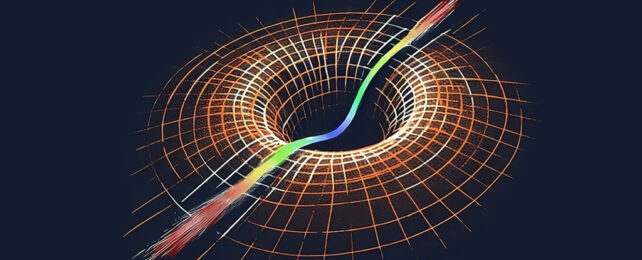Sliding care-free through the complete emptiness of space, light covers a constant 299,792,458 meters every second. No more, no less.
This all changes when that wave of electromagnetism is forced to negotiate the electromagnetic fields surrounding bits of matter. Passing through this quagmire, light's overall speed can slow to a relative crawl.
We see this phenomenon in the bending of light as it travels through a glass of water, or even in the dazzling separation of waves in a rainbow.
While physicists can describe this delay using 19th century equations on light and electromagnetism, they are yet to adequately capture light's abrupt change in speed between different media in measures of physical waves.
A trio of physicists from Tampere University has come up with a potential solution to this problem, but not before reconsidering some fairly fundamental principles on the progress of a light wave through time and a single dimension of space.
"Basically, I found a very neat way to derive the standard wave equation in 1+1 dimensions," says the study's first author, Matias Koivurova, now at the University of Eastern Finland.
"The only assumption I needed was that the speed of the wave is constant. Then I thought to myself: what if it's not always constant? This turned out to be a really good question."
The speed of light – or c to use its shorthand – is a Universal limit for information moving through a vacuum. While matter can effectively slow down a particle's overall journey, the special theory of relativity says this fundamental property cannot truly change.
Yet sometimes physics demands the occasional flight of fancy in order to explore new grounds. So Koivurova, together with his colleagues Charles Robson and Marco Ornigotti, put aside this inconvenient truth to consider the consequences of a standard wave equation where an arbitrary light wave can accelerate.
Initially, their solution didn't make a whole lot of sense. It was only when they added a constant speed back in as a frame of reference that pieces clicked together.
Send a spaceship into the depths of space at speed, and its passengers will experience time and distance differently to the observers watching their journey from afar. This contrast comes courtesy of relativity, a theory that's been tested successfully time and time again on all manner of scales.
By framing an accelerating wave against a constant light speed, the strange effects of the team's novel solution to the standard wave equation looked just like those imposed by relativity. Their realization had profound implications for a debate over whether the momentum of a light wave increased or decreased as it crossed into a new medium.
"What we have shown, is that from the point of view of the wave, nothing happens to its momentum. In other words, the momentum of the wave is conserved," says Koivurova.
No matter what the wave is, whether it's in an electromagnetic field, a ripple on a pond, or a vibration down a string, measures of relativity and the conservation of momentum need to be factored into the equation as they pick up speed. This generalization was to have another rather remarkable, if slightly disappointing consequence.
Whether it's our intrepid space travelers zooming towards Alpha Centauri at a fraction of the speed of light, or their bereaved family aging slowly back on Earth, each of their respective clocks tick away in what is regarded as proper time. The two times might disagree on the length of a second, but each is a reliable measure of the passing of the years inside their own frame.
If all waves also experience proper time care of relativity, the physicists argue, any physics governed by waves ought to have a strict, temporal direction. One that can't simply be reversed for any one part.
So far, the equations have only been solved for a single dimension of space (and time). Experiments would also need to be conducted to see if this perspective of waves holds true.
If so, our collective trip through the Universe is truly a one-way street after all.
This research was published in Optica.
